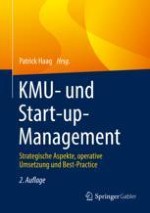2021 | OriginalPaper | Chapter
24. Die Auswahl von geeigneten Nachfolger*innen
Ein Spiel mit vielen Herausforderungen
Author : Sabrina Schell
Published in: KMU- und Start-up-Management
Publisher: Springer Fachmedien Wiesbaden
Activate our intelligent search to find suitable subject content or patents.
Select sections of text to find matching patents with Artificial Intelligence. powered by
Select sections of text to find additional relevant content using AI-assisted search. powered by
